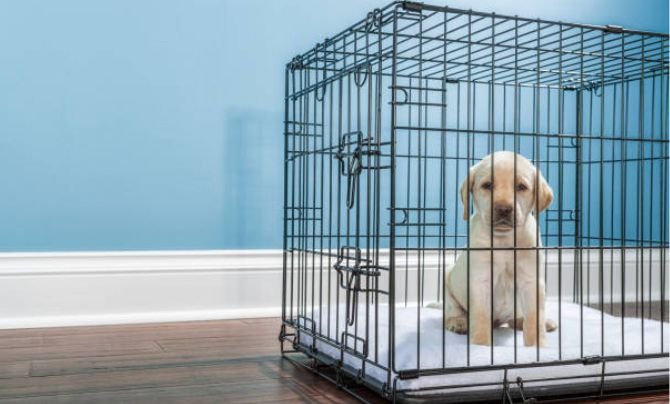Adding a Labrador puppy to your home is a joyous experience—until the first chewed shoe or ruined carpet appears. To prevent accidents and destructive behavior, crate training a Labrador puppy can be a game-changer. Done right, it helps with housebreaking, provides safety, and gives your pup a cozy haven.
1. Choose the Right Crate Style and Size

🏠 Crate Types
- Plastic crates: Airline-approved, secure, easy to clean.
- Wire crates: Well-ventilated; add a cover for privacy during naps or sleep.
Pro tip: Do not leave collars on during crate time—links with wires can cause strangulation.
📏 Crate Size Essentials
- Big enough to allow your Labrador puppy to stand, turn around, and lie down comfortably.
- Not so large that they can sleep in one corner and relieve themselves in another.
- Use a divider or protective boxes to partition the crate if using a large-size option.
2. Introduce the Crate as a Safe Den
To make the crate feel like a retreat, not punishment:
- Add soft bedding like blankets or cushions to encourage your pup to relax.
- Toss treats inside while saying a cue like “Crate!” and let them come and go freely.
- Serve meals inside the crate with the door open to build positive associations.
3. Gradually Close the Door
As your pup gets comfortable entering the crate:
- Place dinner inside, allow free entry and exit.
- Once at ease, close the door for a few minutes while they eat.
- Increase the time gradually—don’t open until your puppy is calm and quiet.
- Use a firm but gentle correction (“No! Quiet!”) if they fuss; only release when quiet resumes.
4. Establish a Consistent Routine
Crate training works best with a structured daily schedule:
- Always crate the puppy overnight in your bedroom for comfort and easy access.
- During the day, crate them near family activity areas but not underfoot.
- Follow a reliable schedule for meals, playtime, crate breaks, and outdoor potty sessions—about every 3 hours, and after waking or eating.
- Puppies shouldn’t be crated for more than a few hours at a time—adjust as needed for work or travel.
Read full: Top 10 Small Soft Dog Bed Reviews
5. Build Independence, Slowly
Once your Labrador puppy reliably uses the crate:
- Keep the door open during the day so they can use it voluntarily as needed.
- Celebrate their independence—let them retreat when safe or overwhelmed.
As they grow, gradually allow more freedom. Never harshly punish; use gentle corrections and firm “No.” presence to reinforce positive behaviors.
6. Why Crate Training Matters Long-Term
- Protects your home: No more chewing on furniture or shoes.
- Keeps your pup safe when unsupervised.
- Helps with travel: Crates are vital for car safety and comfortable boarding.
- Shapes good habits: Creates a trusted sanctuary for rest or anxiety relief.
- Simplifies adult life: A well-trained dog is better adjusted and trustworthy in the future.
7. Stick with It—You’ll See the Rewards
Crate training transforms your Labrador puppy into a well-behaved, secure companion in just 5–10 minutes of consistent daily training. The result?
- A safe, calm dog
- A happy, stress-free home
Don’t lose patience. If you feel overwhelmed at any point, it’s better to get help or find a caring solution than risk neglect or abuse. Always choose kindness and understanding.
Popular post: Top 10 Best Dog Grooming Table Reviews
✅ Final Takeaway
When crate training a Labrador puppy, you’re giving them safety, structure, and a place to call their own. A balanced approach—firm yet loving—builds trust and leads to a confident, well-adjusted dog.






